Research Project: Managing Cultural Diversity in Workplace, Vodafone
VerifiedAdded on 2023/01/03
|29
|6576
|477
Report
AI Summary
This research project, focusing on Vodafone, delves into the critical concept of managing cultural diversity in the workplace. The report begins with an introduction that outlines the background of the research, its aims and objectives, research questions, and the rationale behind the study, emphasizing the importance of cultural diversity for organizational success. A comprehensive literature review follows, exploring the concept of cultural diversity, its positive and negative impacts within Vodafone, and various strategies for implementation to enhance employee performance. The research methodology employed is discussed, providing insights into the data analysis process. The study concludes with recommendations for effective cultural diversity management. The report emphasizes the significance of cultural diversity in fostering innovation, improving employee retention, and achieving organizational goals, while also acknowledging potential challenges such as language barriers and employee resistance. The report provides a detailed analysis of the topic and its importance for modern organizations.

Research Project Final
Paraphrase This Document
Need a fresh take? Get an instant paraphrase of this document with our AI Paraphraser

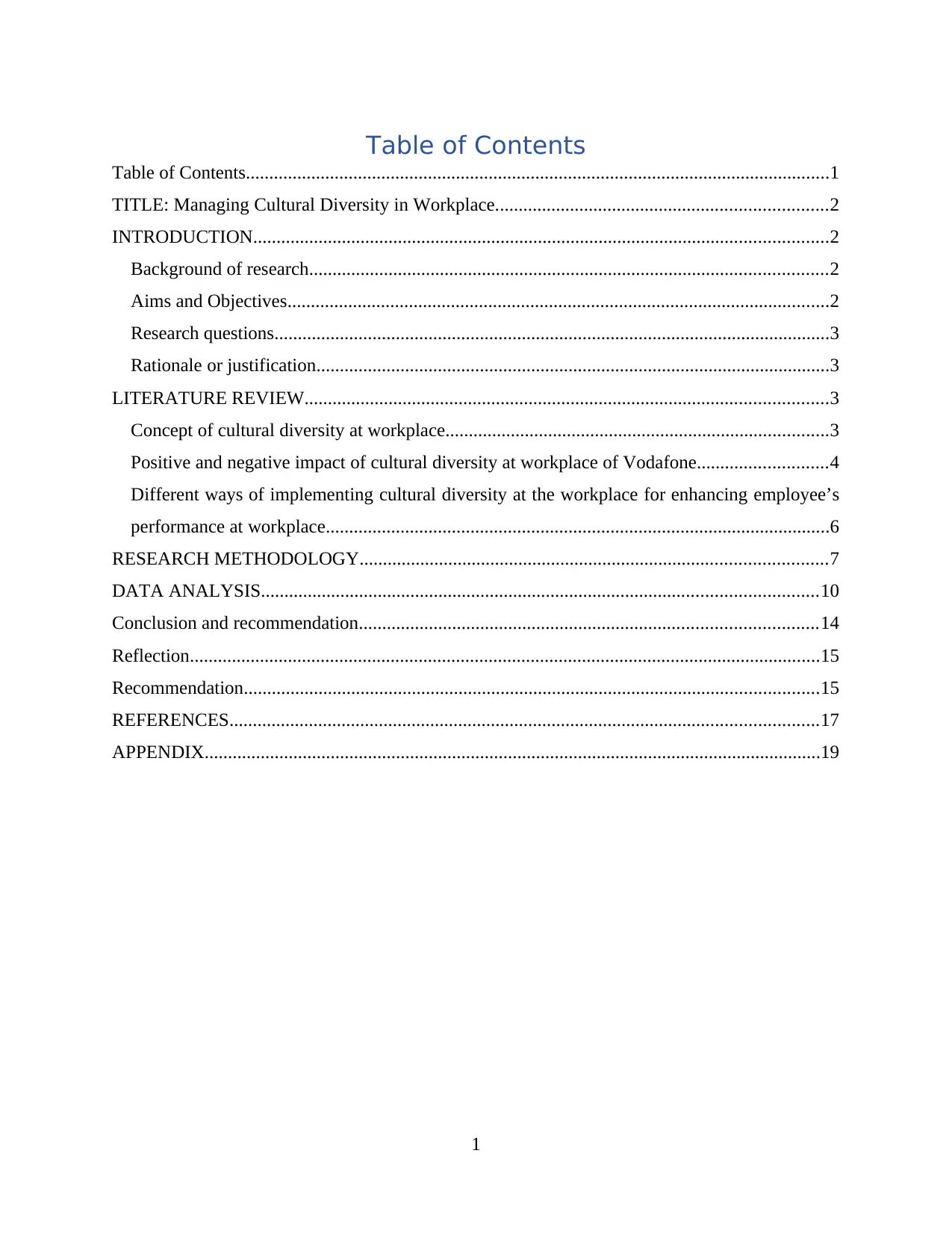
Table of Contents
Table of Contents.............................................................................................................................1
TITLE: Managing Cultural Diversity in Workplace.......................................................................2
INTRODUCTION...........................................................................................................................2
Background of research...............................................................................................................2
Aims and Objectives....................................................................................................................2
Research questions.......................................................................................................................3
Rationale or justification..............................................................................................................3
LITERATURE REVIEW................................................................................................................3
Concept of cultural diversity at workplace..................................................................................3
Positive and negative impact of cultural diversity at workplace of Vodafone............................4
Different ways of implementing cultural diversity at the workplace for enhancing employee’s
performance at workplace............................................................................................................6
RESEARCH METHODOLOGY....................................................................................................7
DATA ANALYSIS.......................................................................................................................10
Conclusion and recommendation..................................................................................................14
Reflection.......................................................................................................................................15
Recommendation...........................................................................................................................15
REFERENCES..............................................................................................................................17
APPENDIX....................................................................................................................................19
1
Table of Contents.............................................................................................................................1
TITLE: Managing Cultural Diversity in Workplace.......................................................................2
INTRODUCTION...........................................................................................................................2
Background of research...............................................................................................................2
Aims and Objectives....................................................................................................................2
Research questions.......................................................................................................................3
Rationale or justification..............................................................................................................3
LITERATURE REVIEW................................................................................................................3
Concept of cultural diversity at workplace..................................................................................3
Positive and negative impact of cultural diversity at workplace of Vodafone............................4
Different ways of implementing cultural diversity at the workplace for enhancing employee’s
performance at workplace............................................................................................................6
RESEARCH METHODOLOGY....................................................................................................7
DATA ANALYSIS.......................................................................................................................10
Conclusion and recommendation..................................................................................................14
Reflection.......................................................................................................................................15
Recommendation...........................................................................................................................15
REFERENCES..............................................................................................................................17
APPENDIX....................................................................................................................................19
1
⊘ This is a preview!⊘
Do you want full access?
Subscribe today to unlock all pages.

Trusted by 1+ million students worldwide
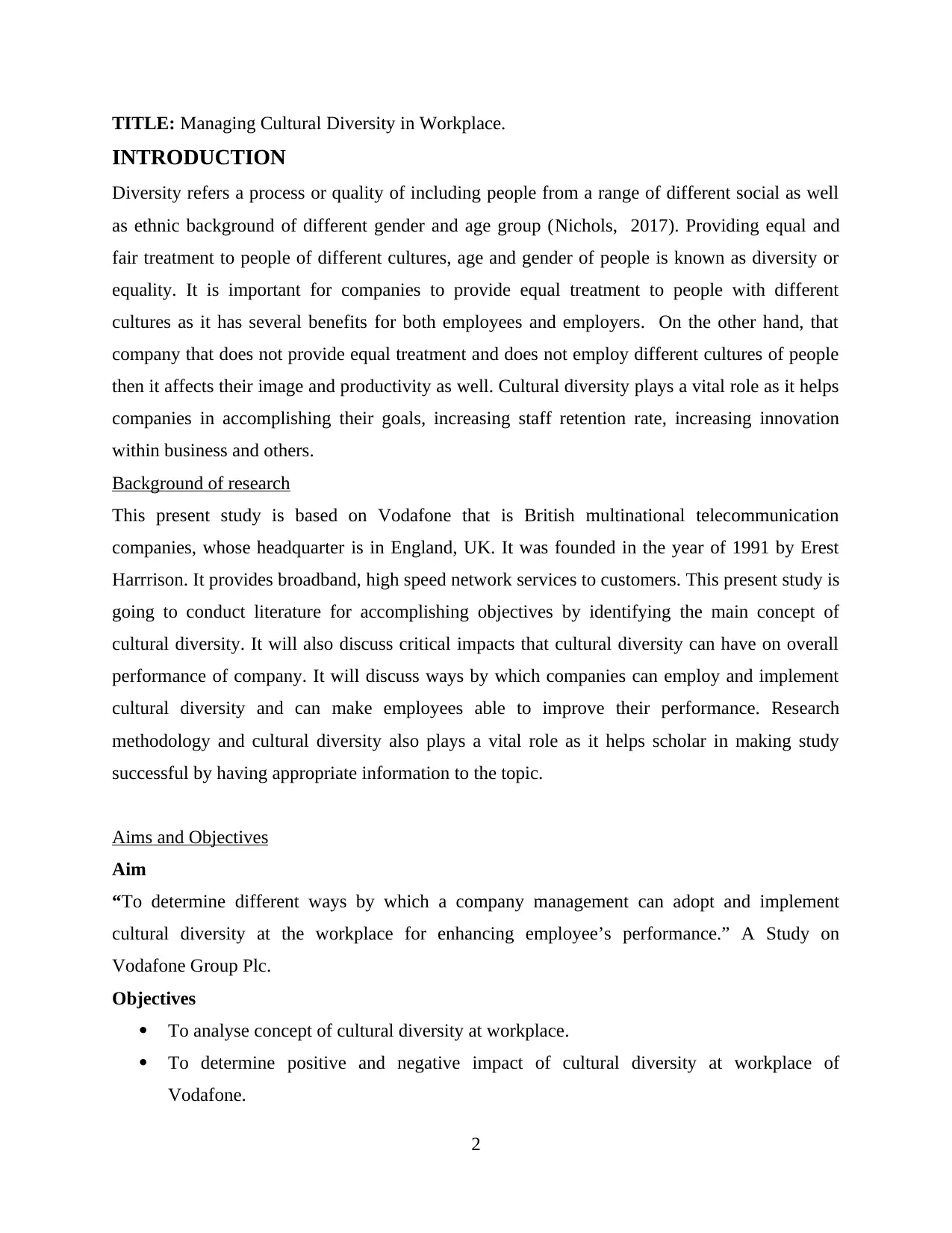
TITLE: Managing Cultural Diversity in Workplace.
INTRODUCTION
Diversity refers a process or quality of including people from a range of different social as well
as ethnic background of different gender and age group (Nichols, 2017). Providing equal and
fair treatment to people of different cultures, age and gender of people is known as diversity or
equality. It is important for companies to provide equal treatment to people with different
cultures as it has several benefits for both employees and employers. On the other hand, that
company that does not provide equal treatment and does not employ different cultures of people
then it affects their image and productivity as well. Cultural diversity plays a vital role as it helps
companies in accomplishing their goals, increasing staff retention rate, increasing innovation
within business and others.
Background of research
This present study is based on Vodafone that is British multinational telecommunication
companies, whose headquarter is in England, UK. It was founded in the year of 1991 by Erest
Harrrison. It provides broadband, high speed network services to customers. This present study is
going to conduct literature for accomplishing objectives by identifying the main concept of
cultural diversity. It will also discuss critical impacts that cultural diversity can have on overall
performance of company. It will discuss ways by which companies can employ and implement
cultural diversity and can make employees able to improve their performance. Research
methodology and cultural diversity also plays a vital role as it helps scholar in making study
successful by having appropriate information to the topic.
Aims and Objectives
Aim
“To determine different ways by which a company management can adopt and implement
cultural diversity at the workplace for enhancing employee’s performance.” A Study on
Vodafone Group Plc.
Objectives
To analyse concept of cultural diversity at workplace.
To determine positive and negative impact of cultural diversity at workplace of
Vodafone.
2
INTRODUCTION
Diversity refers a process or quality of including people from a range of different social as well
as ethnic background of different gender and age group (Nichols, 2017). Providing equal and
fair treatment to people of different cultures, age and gender of people is known as diversity or
equality. It is important for companies to provide equal treatment to people with different
cultures as it has several benefits for both employees and employers. On the other hand, that
company that does not provide equal treatment and does not employ different cultures of people
then it affects their image and productivity as well. Cultural diversity plays a vital role as it helps
companies in accomplishing their goals, increasing staff retention rate, increasing innovation
within business and others.
Background of research
This present study is based on Vodafone that is British multinational telecommunication
companies, whose headquarter is in England, UK. It was founded in the year of 1991 by Erest
Harrrison. It provides broadband, high speed network services to customers. This present study is
going to conduct literature for accomplishing objectives by identifying the main concept of
cultural diversity. It will also discuss critical impacts that cultural diversity can have on overall
performance of company. It will discuss ways by which companies can employ and implement
cultural diversity and can make employees able to improve their performance. Research
methodology and cultural diversity also plays a vital role as it helps scholar in making study
successful by having appropriate information to the topic.
Aims and Objectives
Aim
“To determine different ways by which a company management can adopt and implement
cultural diversity at the workplace for enhancing employee’s performance.” A Study on
Vodafone Group Plc.
Objectives
To analyse concept of cultural diversity at workplace.
To determine positive and negative impact of cultural diversity at workplace of
Vodafone.
2
Paraphrase This Document
Need a fresh take? Get an instant paraphrase of this document with our AI Paraphraser
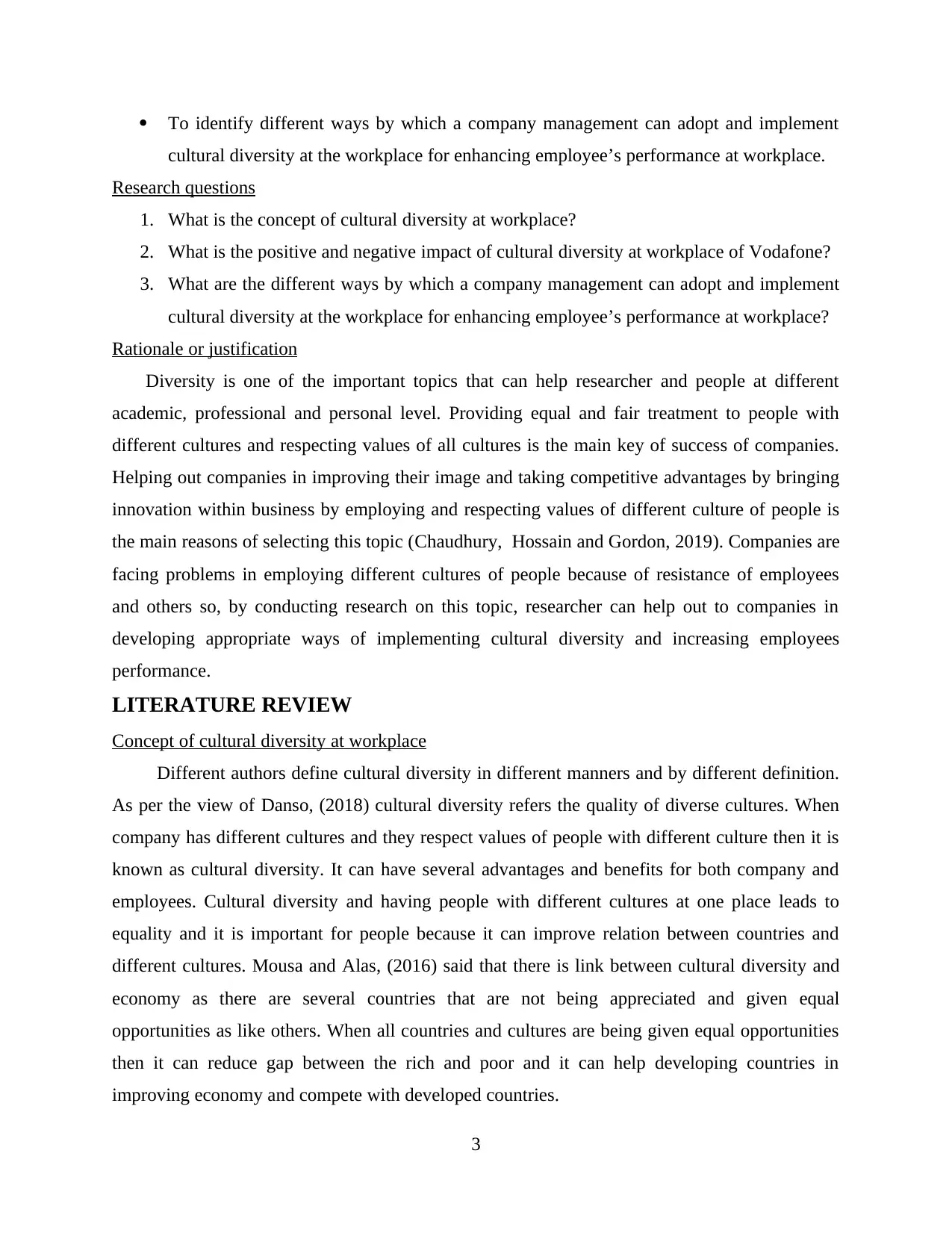
To identify different ways by which a company management can adopt and implement
cultural diversity at the workplace for enhancing employee’s performance at workplace.
Research questions
1. What is the concept of cultural diversity at workplace?
2. What is the positive and negative impact of cultural diversity at workplace of Vodafone?
3. What are the different ways by which a company management can adopt and implement
cultural diversity at the workplace for enhancing employee’s performance at workplace?
Rationale or justification
Diversity is one of the important topics that can help researcher and people at different
academic, professional and personal level. Providing equal and fair treatment to people with
different cultures and respecting values of all cultures is the main key of success of companies.
Helping out companies in improving their image and taking competitive advantages by bringing
innovation within business by employing and respecting values of different culture of people is
the main reasons of selecting this topic (Chaudhury, Hossain and Gordon, 2019). Companies are
facing problems in employing different cultures of people because of resistance of employees
and others so, by conducting research on this topic, researcher can help out to companies in
developing appropriate ways of implementing cultural diversity and increasing employees
performance.
LITERATURE REVIEW
Concept of cultural diversity at workplace
Different authors define cultural diversity in different manners and by different definition.
As per the view of Danso, (2018) cultural diversity refers the quality of diverse cultures. When
company has different cultures and they respect values of people with different culture then it is
known as cultural diversity. It can have several advantages and benefits for both company and
employees. Cultural diversity and having people with different cultures at one place leads to
equality and it is important for people because it can improve relation between countries and
different cultures. Mousa and Alas, (2016) said that there is link between cultural diversity and
economy as there are several countries that are not being appreciated and given equal
opportunities as like others. When all countries and cultures are being given equal opportunities
then it can reduce gap between the rich and poor and it can help developing countries in
improving economy and compete with developed countries.
3
cultural diversity at the workplace for enhancing employee’s performance at workplace.
Research questions
1. What is the concept of cultural diversity at workplace?
2. What is the positive and negative impact of cultural diversity at workplace of Vodafone?
3. What are the different ways by which a company management can adopt and implement
cultural diversity at the workplace for enhancing employee’s performance at workplace?
Rationale or justification
Diversity is one of the important topics that can help researcher and people at different
academic, professional and personal level. Providing equal and fair treatment to people with
different cultures and respecting values of all cultures is the main key of success of companies.
Helping out companies in improving their image and taking competitive advantages by bringing
innovation within business by employing and respecting values of different culture of people is
the main reasons of selecting this topic (Chaudhury, Hossain and Gordon, 2019). Companies are
facing problems in employing different cultures of people because of resistance of employees
and others so, by conducting research on this topic, researcher can help out to companies in
developing appropriate ways of implementing cultural diversity and increasing employees
performance.
LITERATURE REVIEW
Concept of cultural diversity at workplace
Different authors define cultural diversity in different manners and by different definition.
As per the view of Danso, (2018) cultural diversity refers the quality of diverse cultures. When
company has different cultures and they respect values of people with different culture then it is
known as cultural diversity. It can have several advantages and benefits for both company and
employees. Cultural diversity and having people with different cultures at one place leads to
equality and it is important for people because it can improve relation between countries and
different cultures. Mousa and Alas, (2016) said that there is link between cultural diversity and
economy as there are several countries that are not being appreciated and given equal
opportunities as like others. When all countries and cultures are being given equal opportunities
then it can reduce gap between the rich and poor and it can help developing countries in
improving economy and compete with developed countries.
3
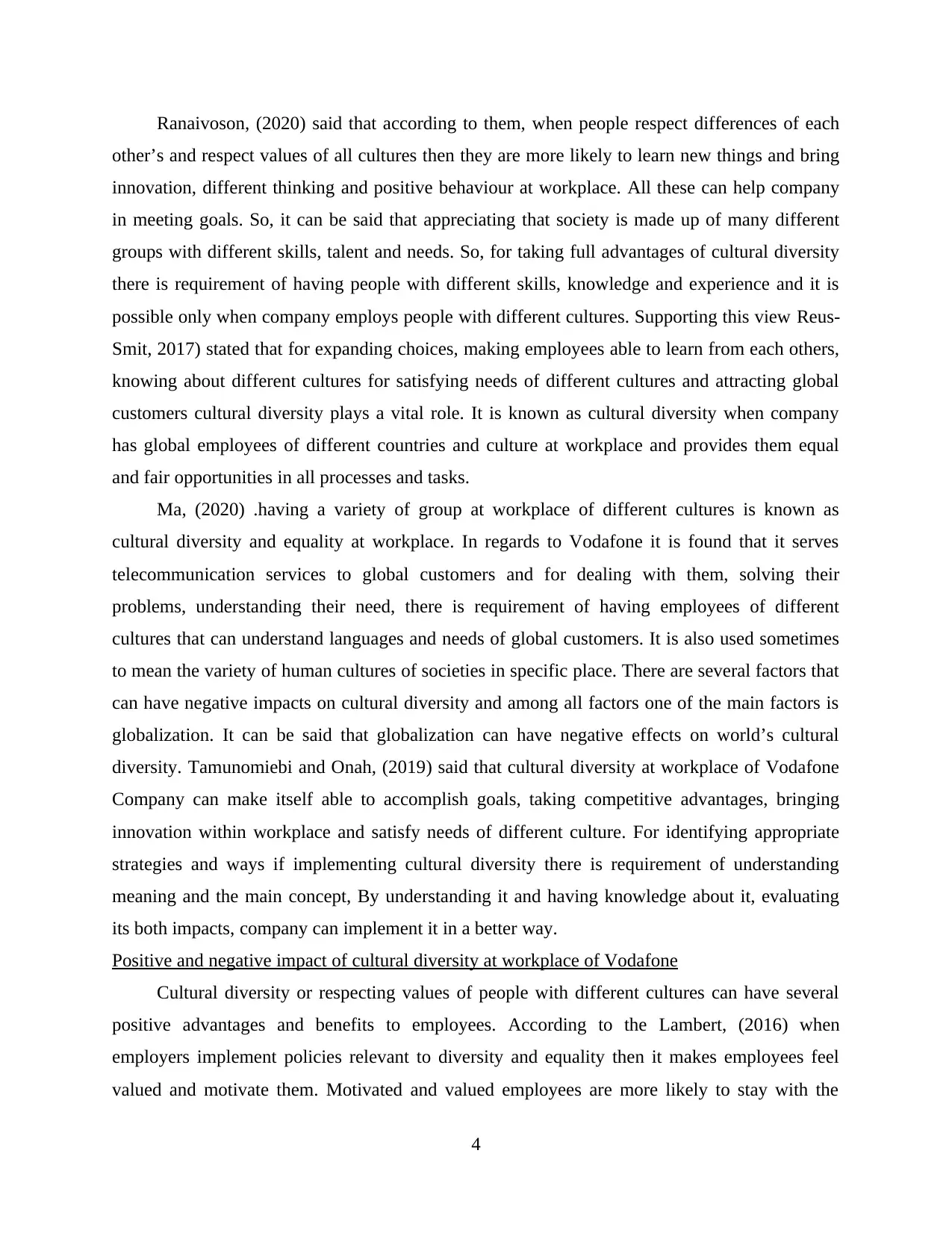
Ranaivoson, (2020) said that according to them, when people respect differences of each
other’s and respect values of all cultures then they are more likely to learn new things and bring
innovation, different thinking and positive behaviour at workplace. All these can help company
in meeting goals. So, it can be said that appreciating that society is made up of many different
groups with different skills, talent and needs. So, for taking full advantages of cultural diversity
there is requirement of having people with different skills, knowledge and experience and it is
possible only when company employs people with different cultures. Supporting this view Reus-
Smit, 2017) stated that for expanding choices, making employees able to learn from each others,
knowing about different cultures for satisfying needs of different cultures and attracting global
customers cultural diversity plays a vital role. It is known as cultural diversity when company
has global employees of different countries and culture at workplace and provides them equal
and fair opportunities in all processes and tasks.
Ma, (2020) .having a variety of group at workplace of different cultures is known as
cultural diversity and equality at workplace. In regards to Vodafone it is found that it serves
telecommunication services to global customers and for dealing with them, solving their
problems, understanding their need, there is requirement of having employees of different
cultures that can understand languages and needs of global customers. It is also used sometimes
to mean the variety of human cultures of societies in specific place. There are several factors that
can have negative impacts on cultural diversity and among all factors one of the main factors is
globalization. It can be said that globalization can have negative effects on world’s cultural
diversity. Tamunomiebi and Onah, (2019) said that cultural diversity at workplace of Vodafone
Company can make itself able to accomplish goals, taking competitive advantages, bringing
innovation within workplace and satisfy needs of different culture. For identifying appropriate
strategies and ways if implementing cultural diversity there is requirement of understanding
meaning and the main concept, By understanding it and having knowledge about it, evaluating
its both impacts, company can implement it in a better way.
Positive and negative impact of cultural diversity at workplace of Vodafone
Cultural diversity or respecting values of people with different cultures can have several
positive advantages and benefits to employees. According to the Lambert, (2016) when
employers implement policies relevant to diversity and equality then it makes employees feel
valued and motivate them. Motivated and valued employees are more likely to stay with the
4
other’s and respect values of all cultures then they are more likely to learn new things and bring
innovation, different thinking and positive behaviour at workplace. All these can help company
in meeting goals. So, it can be said that appreciating that society is made up of many different
groups with different skills, talent and needs. So, for taking full advantages of cultural diversity
there is requirement of having people with different skills, knowledge and experience and it is
possible only when company employs people with different cultures. Supporting this view Reus-
Smit, 2017) stated that for expanding choices, making employees able to learn from each others,
knowing about different cultures for satisfying needs of different cultures and attracting global
customers cultural diversity plays a vital role. It is known as cultural diversity when company
has global employees of different countries and culture at workplace and provides them equal
and fair opportunities in all processes and tasks.
Ma, (2020) .having a variety of group at workplace of different cultures is known as
cultural diversity and equality at workplace. In regards to Vodafone it is found that it serves
telecommunication services to global customers and for dealing with them, solving their
problems, understanding their need, there is requirement of having employees of different
cultures that can understand languages and needs of global customers. It is also used sometimes
to mean the variety of human cultures of societies in specific place. There are several factors that
can have negative impacts on cultural diversity and among all factors one of the main factors is
globalization. It can be said that globalization can have negative effects on world’s cultural
diversity. Tamunomiebi and Onah, (2019) said that cultural diversity at workplace of Vodafone
Company can make itself able to accomplish goals, taking competitive advantages, bringing
innovation within workplace and satisfy needs of different culture. For identifying appropriate
strategies and ways if implementing cultural diversity there is requirement of understanding
meaning and the main concept, By understanding it and having knowledge about it, evaluating
its both impacts, company can implement it in a better way.
Positive and negative impact of cultural diversity at workplace of Vodafone
Cultural diversity or respecting values of people with different cultures can have several
positive advantages and benefits to employees. According to the Lambert, (2016) when
employers implement policies relevant to diversity and equality then it makes employees feel
valued and motivate them. Motivated and valued employees are more likely to stay with the
4
⊘ This is a preview!⊘
Do you want full access?
Subscribe today to unlock all pages.

Trusted by 1+ million students worldwide
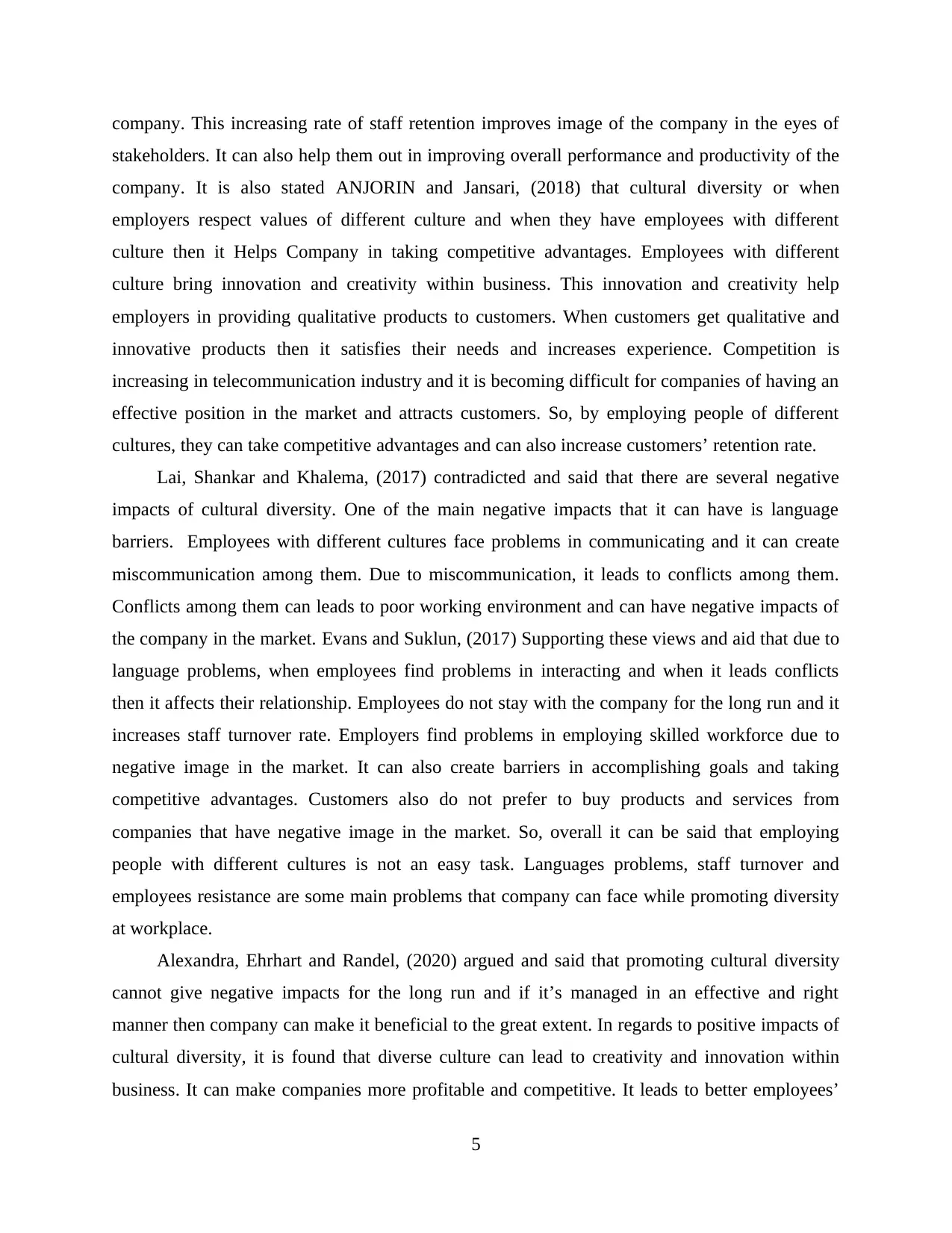
company. This increasing rate of staff retention improves image of the company in the eyes of
stakeholders. It can also help them out in improving overall performance and productivity of the
company. It is also stated ANJORIN and Jansari, (2018) that cultural diversity or when
employers respect values of different culture and when they have employees with different
culture then it Helps Company in taking competitive advantages. Employees with different
culture bring innovation and creativity within business. This innovation and creativity help
employers in providing qualitative products to customers. When customers get qualitative and
innovative products then it satisfies their needs and increases experience. Competition is
increasing in telecommunication industry and it is becoming difficult for companies of having an
effective position in the market and attracts customers. So, by employing people of different
cultures, they can take competitive advantages and can also increase customers’ retention rate.
Lai, Shankar and Khalema, (2017) contradicted and said that there are several negative
impacts of cultural diversity. One of the main negative impacts that it can have is language
barriers. Employees with different cultures face problems in communicating and it can create
miscommunication among them. Due to miscommunication, it leads to conflicts among them.
Conflicts among them can leads to poor working environment and can have negative impacts of
the company in the market. Evans and Suklun, (2017) Supporting these views and aid that due to
language problems, when employees find problems in interacting and when it leads conflicts
then it affects their relationship. Employees do not stay with the company for the long run and it
increases staff turnover rate. Employers find problems in employing skilled workforce due to
negative image in the market. It can also create barriers in accomplishing goals and taking
competitive advantages. Customers also do not prefer to buy products and services from
companies that have negative image in the market. So, overall it can be said that employing
people with different cultures is not an easy task. Languages problems, staff turnover and
employees resistance are some main problems that company can face while promoting diversity
at workplace.
Alexandra, Ehrhart and Randel, (2020) argued and said that promoting cultural diversity
cannot give negative impacts for the long run and if it’s managed in an effective and right
manner then company can make it beneficial to the great extent. In regards to positive impacts of
cultural diversity, it is found that diverse culture can lead to creativity and innovation within
business. It can make companies more profitable and competitive. It leads to better employees’
5
stakeholders. It can also help them out in improving overall performance and productivity of the
company. It is also stated ANJORIN and Jansari, (2018) that cultural diversity or when
employers respect values of different culture and when they have employees with different
culture then it Helps Company in taking competitive advantages. Employees with different
culture bring innovation and creativity within business. This innovation and creativity help
employers in providing qualitative products to customers. When customers get qualitative and
innovative products then it satisfies their needs and increases experience. Competition is
increasing in telecommunication industry and it is becoming difficult for companies of having an
effective position in the market and attracts customers. So, by employing people of different
cultures, they can take competitive advantages and can also increase customers’ retention rate.
Lai, Shankar and Khalema, (2017) contradicted and said that there are several negative
impacts of cultural diversity. One of the main negative impacts that it can have is language
barriers. Employees with different cultures face problems in communicating and it can create
miscommunication among them. Due to miscommunication, it leads to conflicts among them.
Conflicts among them can leads to poor working environment and can have negative impacts of
the company in the market. Evans and Suklun, (2017) Supporting these views and aid that due to
language problems, when employees find problems in interacting and when it leads conflicts
then it affects their relationship. Employees do not stay with the company for the long run and it
increases staff turnover rate. Employers find problems in employing skilled workforce due to
negative image in the market. It can also create barriers in accomplishing goals and taking
competitive advantages. Customers also do not prefer to buy products and services from
companies that have negative image in the market. So, overall it can be said that employing
people with different cultures is not an easy task. Languages problems, staff turnover and
employees resistance are some main problems that company can face while promoting diversity
at workplace.
Alexandra, Ehrhart and Randel, (2020) argued and said that promoting cultural diversity
cannot give negative impacts for the long run and if it’s managed in an effective and right
manner then company can make it beneficial to the great extent. In regards to positive impacts of
cultural diversity, it is found that diverse culture can lead to creativity and innovation within
business. It can make companies more profitable and competitive. It leads to better employees’
5
Paraphrase This Document
Need a fresh take? Get an instant paraphrase of this document with our AI Paraphraser
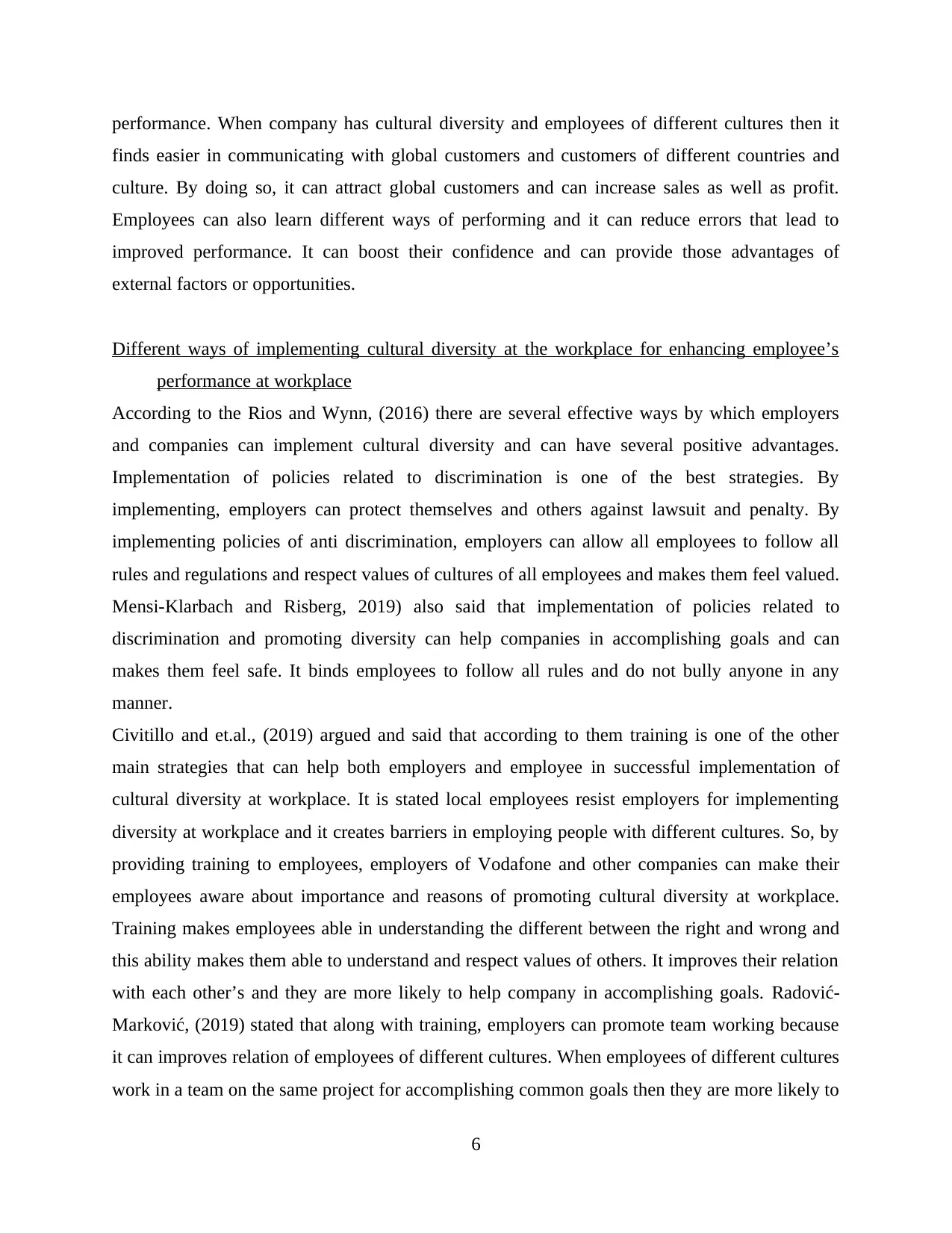
performance. When company has cultural diversity and employees of different cultures then it
finds easier in communicating with global customers and customers of different countries and
culture. By doing so, it can attract global customers and can increase sales as well as profit.
Employees can also learn different ways of performing and it can reduce errors that lead to
improved performance. It can boost their confidence and can provide those advantages of
external factors or opportunities.
Different ways of implementing cultural diversity at the workplace for enhancing employee’s
performance at workplace
According to the Rios and Wynn, (2016) there are several effective ways by which employers
and companies can implement cultural diversity and can have several positive advantages.
Implementation of policies related to discrimination is one of the best strategies. By
implementing, employers can protect themselves and others against lawsuit and penalty. By
implementing policies of anti discrimination, employers can allow all employees to follow all
rules and regulations and respect values of cultures of all employees and makes them feel valued.
Mensi-Klarbach and Risberg, 2019) also said that implementation of policies related to
discrimination and promoting diversity can help companies in accomplishing goals and can
makes them feel safe. It binds employees to follow all rules and do not bully anyone in any
manner.
Civitillo and et.al., (2019) argued and said that according to them training is one of the other
main strategies that can help both employers and employee in successful implementation of
cultural diversity at workplace. It is stated local employees resist employers for implementing
diversity at workplace and it creates barriers in employing people with different cultures. So, by
providing training to employees, employers of Vodafone and other companies can make their
employees aware about importance and reasons of promoting cultural diversity at workplace.
Training makes employees able in understanding the different between the right and wrong and
this ability makes them able to understand and respect values of others. It improves their relation
with each other’s and they are more likely to help company in accomplishing goals. Radović-
Marković, (2019) stated that along with training, employers can promote team working because
it can improves relation of employees of different cultures. When employees of different cultures
work in a team on the same project for accomplishing common goals then they are more likely to
6
finds easier in communicating with global customers and customers of different countries and
culture. By doing so, it can attract global customers and can increase sales as well as profit.
Employees can also learn different ways of performing and it can reduce errors that lead to
improved performance. It can boost their confidence and can provide those advantages of
external factors or opportunities.
Different ways of implementing cultural diversity at the workplace for enhancing employee’s
performance at workplace
According to the Rios and Wynn, (2016) there are several effective ways by which employers
and companies can implement cultural diversity and can have several positive advantages.
Implementation of policies related to discrimination is one of the best strategies. By
implementing, employers can protect themselves and others against lawsuit and penalty. By
implementing policies of anti discrimination, employers can allow all employees to follow all
rules and regulations and respect values of cultures of all employees and makes them feel valued.
Mensi-Klarbach and Risberg, 2019) also said that implementation of policies related to
discrimination and promoting diversity can help companies in accomplishing goals and can
makes them feel safe. It binds employees to follow all rules and do not bully anyone in any
manner.
Civitillo and et.al., (2019) argued and said that according to them training is one of the other
main strategies that can help both employers and employee in successful implementation of
cultural diversity at workplace. It is stated local employees resist employers for implementing
diversity at workplace and it creates barriers in employing people with different cultures. So, by
providing training to employees, employers of Vodafone and other companies can make their
employees aware about importance and reasons of promoting cultural diversity at workplace.
Training makes employees able in understanding the different between the right and wrong and
this ability makes them able to understand and respect values of others. It improves their relation
with each other’s and they are more likely to help company in accomplishing goals. Radović-
Marković, (2019) stated that along with training, employers can promote team working because
it can improves relation of employees of different cultures. When employees of different cultures
work in a team on the same project for accomplishing common goals then they are more likely to
6
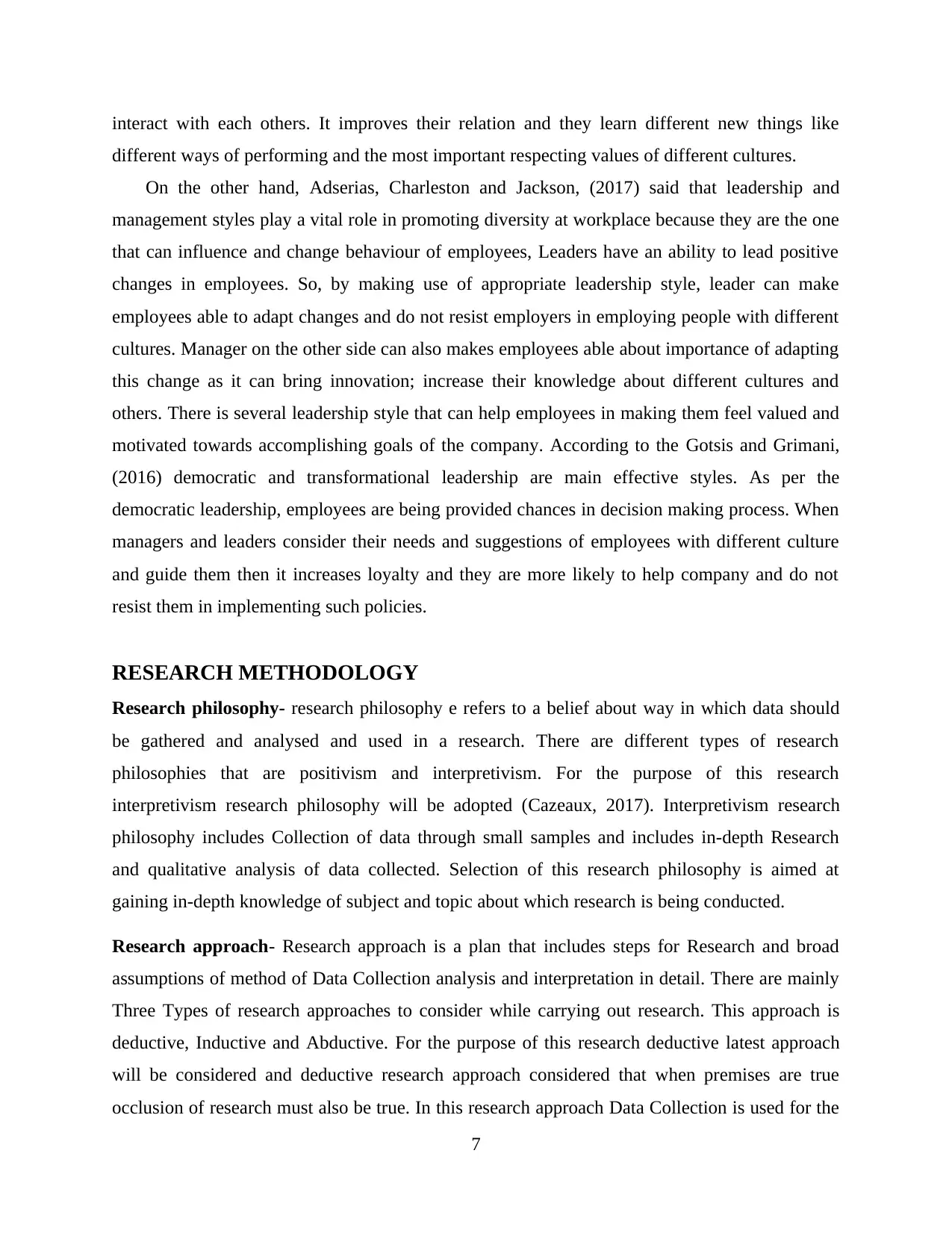
interact with each others. It improves their relation and they learn different new things like
different ways of performing and the most important respecting values of different cultures.
On the other hand, Adserias, Charleston and Jackson, (2017) said that leadership and
management styles play a vital role in promoting diversity at workplace because they are the one
that can influence and change behaviour of employees, Leaders have an ability to lead positive
changes in employees. So, by making use of appropriate leadership style, leader can make
employees able to adapt changes and do not resist employers in employing people with different
cultures. Manager on the other side can also makes employees able about importance of adapting
this change as it can bring innovation; increase their knowledge about different cultures and
others. There is several leadership style that can help employees in making them feel valued and
motivated towards accomplishing goals of the company. According to the Gotsis and Grimani,
(2016) democratic and transformational leadership are main effective styles. As per the
democratic leadership, employees are being provided chances in decision making process. When
managers and leaders consider their needs and suggestions of employees with different culture
and guide them then it increases loyalty and they are more likely to help company and do not
resist them in implementing such policies.
RESEARCH METHODOLOGY
Research philosophy- research philosophy e refers to a belief about way in which data should
be gathered and analysed and used in a research. There are different types of research
philosophies that are positivism and interpretivism. For the purpose of this research
interpretivism research philosophy will be adopted (Cazeaux, 2017). Interpretivism research
philosophy includes Collection of data through small samples and includes in-depth Research
and qualitative analysis of data collected. Selection of this research philosophy is aimed at
gaining in-depth knowledge of subject and topic about which research is being conducted.
Research approach- Research approach is a plan that includes steps for Research and broad
assumptions of method of Data Collection analysis and interpretation in detail. There are mainly
Three Types of research approaches to consider while carrying out research. This approach is
deductive, Inductive and Abductive. For the purpose of this research deductive latest approach
will be considered and deductive research approach considered that when premises are true
occlusion of research must also be true. In this research approach Data Collection is used for the
7
different ways of performing and the most important respecting values of different cultures.
On the other hand, Adserias, Charleston and Jackson, (2017) said that leadership and
management styles play a vital role in promoting diversity at workplace because they are the one
that can influence and change behaviour of employees, Leaders have an ability to lead positive
changes in employees. So, by making use of appropriate leadership style, leader can make
employees able to adapt changes and do not resist employers in employing people with different
cultures. Manager on the other side can also makes employees able about importance of adapting
this change as it can bring innovation; increase their knowledge about different cultures and
others. There is several leadership style that can help employees in making them feel valued and
motivated towards accomplishing goals of the company. According to the Gotsis and Grimani,
(2016) democratic and transformational leadership are main effective styles. As per the
democratic leadership, employees are being provided chances in decision making process. When
managers and leaders consider their needs and suggestions of employees with different culture
and guide them then it increases loyalty and they are more likely to help company and do not
resist them in implementing such policies.
RESEARCH METHODOLOGY
Research philosophy- research philosophy e refers to a belief about way in which data should
be gathered and analysed and used in a research. There are different types of research
philosophies that are positivism and interpretivism. For the purpose of this research
interpretivism research philosophy will be adopted (Cazeaux, 2017). Interpretivism research
philosophy includes Collection of data through small samples and includes in-depth Research
and qualitative analysis of data collected. Selection of this research philosophy is aimed at
gaining in-depth knowledge of subject and topic about which research is being conducted.
Research approach- Research approach is a plan that includes steps for Research and broad
assumptions of method of Data Collection analysis and interpretation in detail. There are mainly
Three Types of research approaches to consider while carrying out research. This approach is
deductive, Inductive and Abductive. For the purpose of this research deductive latest approach
will be considered and deductive research approach considered that when premises are true
occlusion of research must also be true. In this research approach Data Collection is used for the
7
⊘ This is a preview!⊘
Do you want full access?
Subscribe today to unlock all pages.

Trusted by 1+ million students worldwide
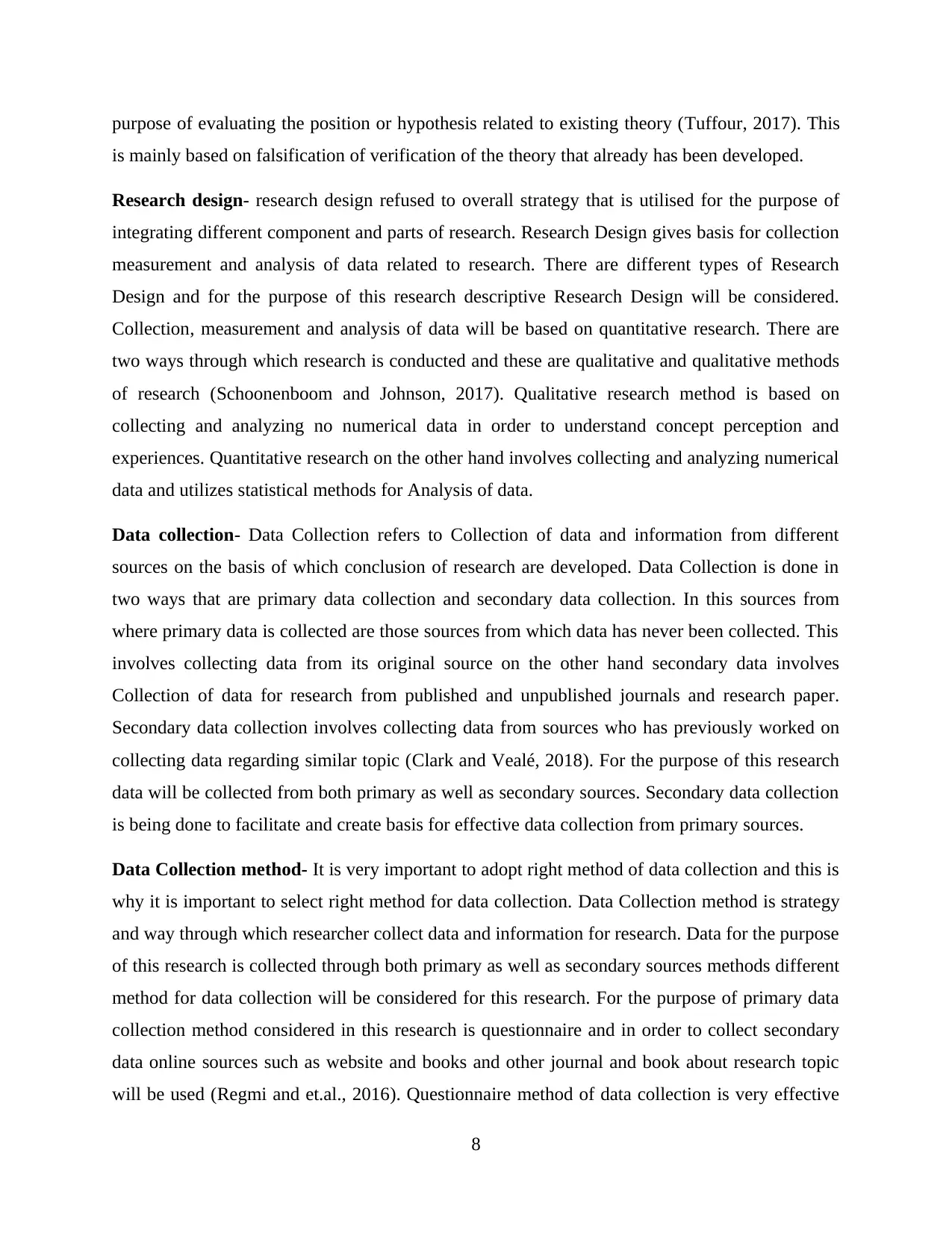
purpose of evaluating the position or hypothesis related to existing theory (Tuffour, 2017). This
is mainly based on falsification of verification of the theory that already has been developed.
Research design- research design refused to overall strategy that is utilised for the purpose of
integrating different component and parts of research. Research Design gives basis for collection
measurement and analysis of data related to research. There are different types of Research
Design and for the purpose of this research descriptive Research Design will be considered.
Collection, measurement and analysis of data will be based on quantitative research. There are
two ways through which research is conducted and these are qualitative and qualitative methods
of research (Schoonenboom and Johnson, 2017). Qualitative research method is based on
collecting and analyzing no numerical data in order to understand concept perception and
experiences. Quantitative research on the other hand involves collecting and analyzing numerical
data and utilizes statistical methods for Analysis of data.
Data collection- Data Collection refers to Collection of data and information from different
sources on the basis of which conclusion of research are developed. Data Collection is done in
two ways that are primary data collection and secondary data collection. In this sources from
where primary data is collected are those sources from which data has never been collected. This
involves collecting data from its original source on the other hand secondary data involves
Collection of data for research from published and unpublished journals and research paper.
Secondary data collection involves collecting data from sources who has previously worked on
collecting data regarding similar topic (Clark and Vealé, 2018). For the purpose of this research
data will be collected from both primary as well as secondary sources. Secondary data collection
is being done to facilitate and create basis for effective data collection from primary sources.
Data Collection method- It is very important to adopt right method of data collection and this is
why it is important to select right method for data collection. Data Collection method is strategy
and way through which researcher collect data and information for research. Data for the purpose
of this research is collected through both primary as well as secondary sources methods different
method for data collection will be considered for this research. For the purpose of primary data
collection method considered in this research is questionnaire and in order to collect secondary
data online sources such as website and books and other journal and book about research topic
will be used (Regmi and et.al., 2016). Questionnaire method of data collection is very effective
8
is mainly based on falsification of verification of the theory that already has been developed.
Research design- research design refused to overall strategy that is utilised for the purpose of
integrating different component and parts of research. Research Design gives basis for collection
measurement and analysis of data related to research. There are different types of Research
Design and for the purpose of this research descriptive Research Design will be considered.
Collection, measurement and analysis of data will be based on quantitative research. There are
two ways through which research is conducted and these are qualitative and qualitative methods
of research (Schoonenboom and Johnson, 2017). Qualitative research method is based on
collecting and analyzing no numerical data in order to understand concept perception and
experiences. Quantitative research on the other hand involves collecting and analyzing numerical
data and utilizes statistical methods for Analysis of data.
Data collection- Data Collection refers to Collection of data and information from different
sources on the basis of which conclusion of research are developed. Data Collection is done in
two ways that are primary data collection and secondary data collection. In this sources from
where primary data is collected are those sources from which data has never been collected. This
involves collecting data from its original source on the other hand secondary data involves
Collection of data for research from published and unpublished journals and research paper.
Secondary data collection involves collecting data from sources who has previously worked on
collecting data regarding similar topic (Clark and Vealé, 2018). For the purpose of this research
data will be collected from both primary as well as secondary sources. Secondary data collection
is being done to facilitate and create basis for effective data collection from primary sources.
Data Collection method- It is very important to adopt right method of data collection and this is
why it is important to select right method for data collection. Data Collection method is strategy
and way through which researcher collect data and information for research. Data for the purpose
of this research is collected through both primary as well as secondary sources methods different
method for data collection will be considered for this research. For the purpose of primary data
collection method considered in this research is questionnaire and in order to collect secondary
data online sources such as website and books and other journal and book about research topic
will be used (Regmi and et.al., 2016). Questionnaire method of data collection is very effective
8
Paraphrase This Document
Need a fresh take? Get an instant paraphrase of this document with our AI Paraphraser
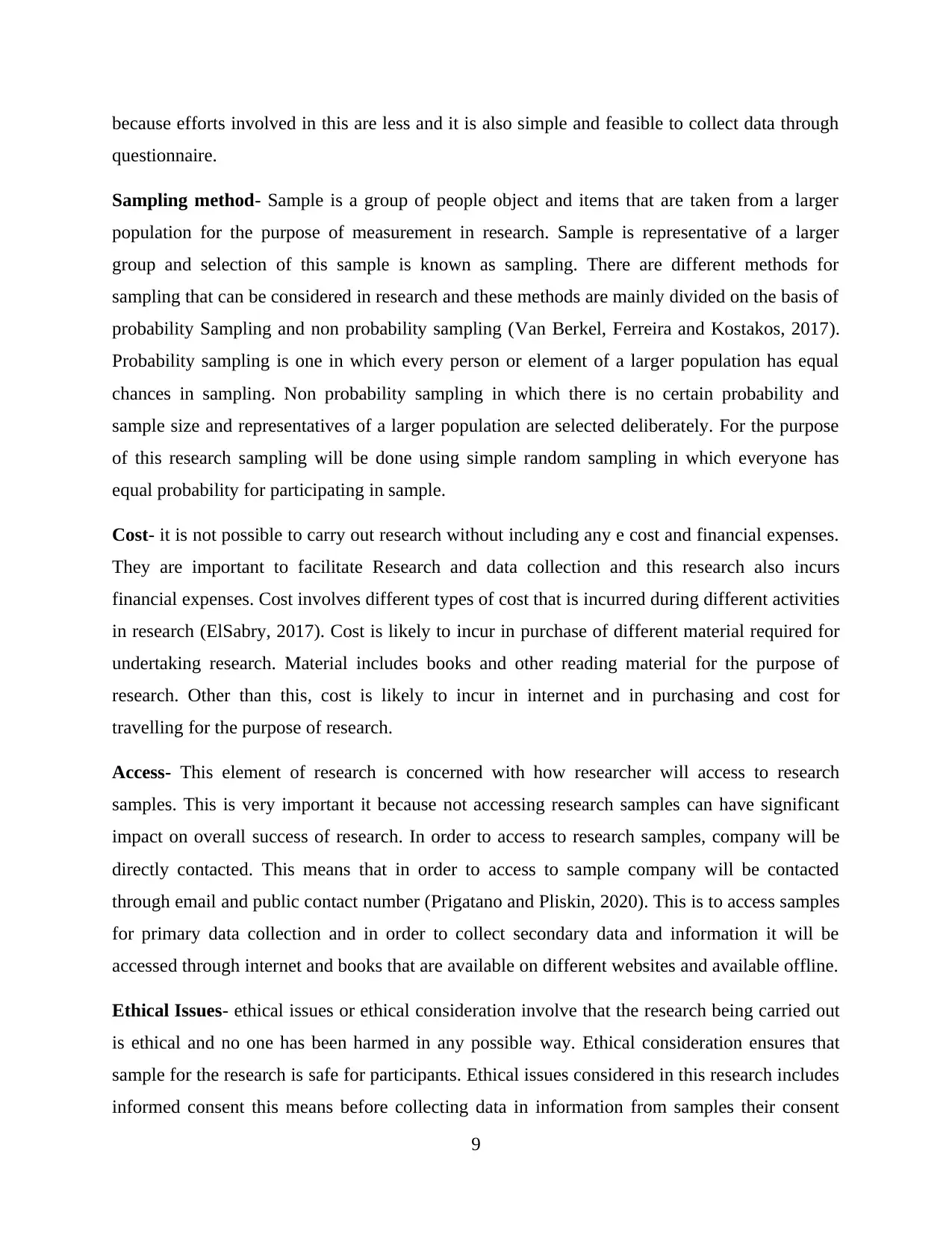
because efforts involved in this are less and it is also simple and feasible to collect data through
questionnaire.
Sampling method- Sample is a group of people object and items that are taken from a larger
population for the purpose of measurement in research. Sample is representative of a larger
group and selection of this sample is known as sampling. There are different methods for
sampling that can be considered in research and these methods are mainly divided on the basis of
probability Sampling and non probability sampling (Van Berkel, Ferreira and Kostakos, 2017).
Probability sampling is one in which every person or element of a larger population has equal
chances in sampling. Non probability sampling in which there is no certain probability and
sample size and representatives of a larger population are selected deliberately. For the purpose
of this research sampling will be done using simple random sampling in which everyone has
equal probability for participating in sample.
Cost- it is not possible to carry out research without including any e cost and financial expenses.
They are important to facilitate Research and data collection and this research also incurs
financial expenses. Cost involves different types of cost that is incurred during different activities
in research (ElSabry, 2017). Cost is likely to incur in purchase of different material required for
undertaking research. Material includes books and other reading material for the purpose of
research. Other than this, cost is likely to incur in internet and in purchasing and cost for
travelling for the purpose of research.
Access- This element of research is concerned with how researcher will access to research
samples. This is very important it because not accessing research samples can have significant
impact on overall success of research. In order to access to research samples, company will be
directly contacted. This means that in order to access to sample company will be contacted
through email and public contact number (Prigatano and Pliskin, 2020). This is to access samples
for primary data collection and in order to collect secondary data and information it will be
accessed through internet and books that are available on different websites and available offline.
Ethical Issues- ethical issues or ethical consideration involve that the research being carried out
is ethical and no one has been harmed in any possible way. Ethical consideration ensures that
sample for the research is safe for participants. Ethical issues considered in this research includes
informed consent this means before collecting data in information from samples their consent
9
questionnaire.
Sampling method- Sample is a group of people object and items that are taken from a larger
population for the purpose of measurement in research. Sample is representative of a larger
group and selection of this sample is known as sampling. There are different methods for
sampling that can be considered in research and these methods are mainly divided on the basis of
probability Sampling and non probability sampling (Van Berkel, Ferreira and Kostakos, 2017).
Probability sampling is one in which every person or element of a larger population has equal
chances in sampling. Non probability sampling in which there is no certain probability and
sample size and representatives of a larger population are selected deliberately. For the purpose
of this research sampling will be done using simple random sampling in which everyone has
equal probability for participating in sample.
Cost- it is not possible to carry out research without including any e cost and financial expenses.
They are important to facilitate Research and data collection and this research also incurs
financial expenses. Cost involves different types of cost that is incurred during different activities
in research (ElSabry, 2017). Cost is likely to incur in purchase of different material required for
undertaking research. Material includes books and other reading material for the purpose of
research. Other than this, cost is likely to incur in internet and in purchasing and cost for
travelling for the purpose of research.
Access- This element of research is concerned with how researcher will access to research
samples. This is very important it because not accessing research samples can have significant
impact on overall success of research. In order to access to research samples, company will be
directly contacted. This means that in order to access to sample company will be contacted
through email and public contact number (Prigatano and Pliskin, 2020). This is to access samples
for primary data collection and in order to collect secondary data and information it will be
accessed through internet and books that are available on different websites and available offline.
Ethical Issues- ethical issues or ethical consideration involve that the research being carried out
is ethical and no one has been harmed in any possible way. Ethical consideration ensures that
sample for the research is safe for participants. Ethical issues considered in this research includes
informed consent this means before collecting data in information from samples their consent
9
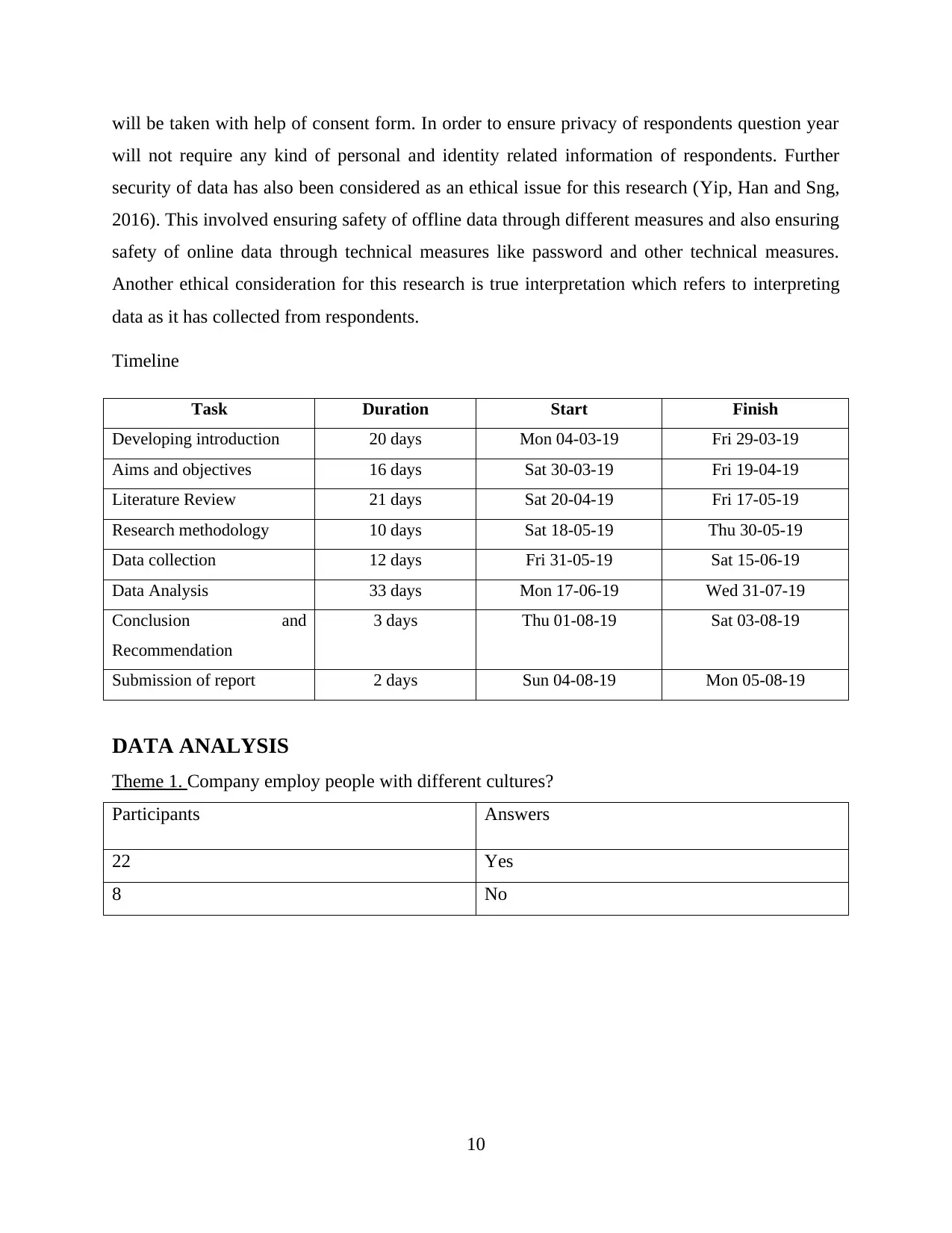
will be taken with help of consent form. In order to ensure privacy of respondents question year
will not require any kind of personal and identity related information of respondents. Further
security of data has also been considered as an ethical issue for this research (Yip, Han and Sng,
2016). This involved ensuring safety of offline data through different measures and also ensuring
safety of online data through technical measures like password and other technical measures.
Another ethical consideration for this research is true interpretation which refers to interpreting
data as it has collected from respondents.
Timeline
Task Duration Start Finish
Developing introduction 20 days Mon 04-03-19 Fri 29-03-19
Aims and objectives 16 days Sat 30-03-19 Fri 19-04-19
Literature Review 21 days Sat 20-04-19 Fri 17-05-19
Research methodology 10 days Sat 18-05-19 Thu 30-05-19
Data collection 12 days Fri 31-05-19 Sat 15-06-19
Data Analysis 33 days Mon 17-06-19 Wed 31-07-19
Conclusion and
Recommendation
3 days Thu 01-08-19 Sat 03-08-19
Submission of report 2 days Sun 04-08-19 Mon 05-08-19
DATA ANALYSIS
Theme 1. Company employ people with different cultures?
Participants Answers
22 Yes
8 No
10
will not require any kind of personal and identity related information of respondents. Further
security of data has also been considered as an ethical issue for this research (Yip, Han and Sng,
2016). This involved ensuring safety of offline data through different measures and also ensuring
safety of online data through technical measures like password and other technical measures.
Another ethical consideration for this research is true interpretation which refers to interpreting
data as it has collected from respondents.
Timeline
Task Duration Start Finish
Developing introduction 20 days Mon 04-03-19 Fri 29-03-19
Aims and objectives 16 days Sat 30-03-19 Fri 19-04-19
Literature Review 21 days Sat 20-04-19 Fri 17-05-19
Research methodology 10 days Sat 18-05-19 Thu 30-05-19
Data collection 12 days Fri 31-05-19 Sat 15-06-19
Data Analysis 33 days Mon 17-06-19 Wed 31-07-19
Conclusion and
Recommendation
3 days Thu 01-08-19 Sat 03-08-19
Submission of report 2 days Sun 04-08-19 Mon 05-08-19
DATA ANALYSIS
Theme 1. Company employ people with different cultures?
Participants Answers
22 Yes
8 No
10
⊘ This is a preview!⊘
Do you want full access?
Subscribe today to unlock all pages.

Trusted by 1+ million students worldwide
1 out of 29
Related Documents
Your All-in-One AI-Powered Toolkit for Academic Success.
+13062052269
info@desklib.com
Available 24*7 on WhatsApp / Email
![[object Object]](/_next/static/media/star-bottom.7253800d.svg)
Unlock your academic potential
Copyright © 2020–2025 A2Z Services. All Rights Reserved. Developed and managed by ZUCOL.





